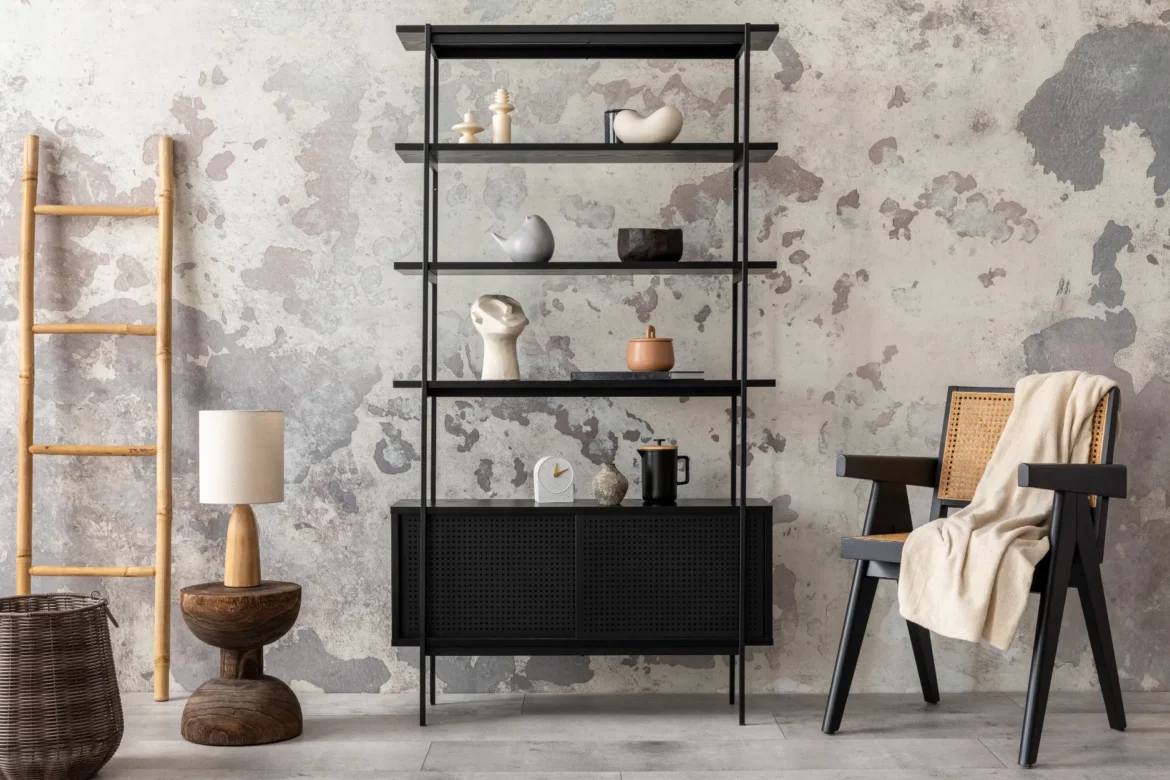Celebrating Not So Perfect Interior Design Through Wabi-Sabi Wonders: 3 Tips
Overview
Discover the transformative power of Wabi-Sabi in interior design. Embrace imperfections, simplicity, and authenticity for a timeless and tranquil home.
Wabi-Sabi teaches us to discover beauty in imperfection, simplicity in the ordinary, and tranquility in the transient. In the captivating realm of Wabi-Sabi, imperfections aren’t just tolerated but cherished, and beauty thrives in the simplicity of the everyday. In the domain of interior design, Wabi-Sabi stands as a philosophy that transcends passing trends, offering a timeless approach that connects with the soul of a space.
Wabi-Sabi, at its essence, represents a Japanese aesthetic and worldview that finds beauty in life’s imperfections, impermanence, and simplicity. It entails embracing the inherent flaws and fleeting nature of existence, prioritizing authenticity over flawless perfection. As one seasoned interior designer aptly expresses, Wabi-Sabi encourages us to “appreciate the beauty that emerges from the natural wear and tear of objects, celebrating their unique history and character.”
Rooted in the traditions of Japanese tea ceremonies and Zen Buddhism, Wabi-Sabi emerged as a response to the opulence dominating aesthetics in the 15th century. “Wabi” initially referred to the solitude of living in nature, while “Sabi” conveyed the beauty found in the passage of time. These concepts converged to form a philosophy embracing simplicity, imperfection, and the transient essence of all things.
Wabi-Sabi’s influence extends beyond aesthetics; it fosters a mindful way of life, guiding individuals to find contentment in the present moment and appreciate the beauty inherent in everyday experiences. Drawing inspiration from the cycles of nature and the beauty that evolves with time, Wabi-Sabi transforms spaces into reflections of life’s evolving journey.
As professionals, we yearn for the authenticity and warmth that Wabi-Sabi brings to our living spaces. Modern interior design, often characterized by sleek lines and perfect symmetry, is increasingly integrating Wabi-Sabi principles to instill a sense of calm and ground. It aligns seamlessly with the growing desire for sustainable and eco-friendly choices, emphasizing the use of natural materials and the repurposing of existing elements, and serves as a counterbalance to standardized aesthetics, offering a unique and profoundly personal touch to interior design.
Core Principles Of Wabi-Sabi
In the heart of Wabi-Sabi, the core principles breathe life into philosophy, transforming spaces into sanctuaries of authenticity and tranquility. In the same manner, these principles serve as guiding lights, steering you away from the conventional and towards a celebration of imperfection, simplicity, transience, and a harmonious connection with nature in the world of interior design.
Beauty In Imperfection
Celebrating Natural Flaws and Imperfections
In the realm of Wabi-Sabi, imperfections are not blemishes to be hidden but treasures to be celebrated. Embrace the weathered surface of a well-loved wooden table, cherish the cracks in aged ceramics, and find beauty in the irregularities of handmade textiles. These imperfections tell stories, adding character to your living space. Example: A slightly uneven hand-painted mural on the living room wall can become a focal point, telling a unique story of the artist’s process.
Contrast With Western Ideals Of Perfection
Wabi-sabi stands in stark contrast to Western ideals of flawless precision. While Western design often strives for perfection and symmetry, Wabi-Sabi invites you to appreciate the beauty in asymmetry and irregularity. It’s a departure from the pristine and warm embrace of the lived-in. For instance, Instead of a perfectly matched set of dining chairs, consider a mix of vintage chairs with varying patinas for a more eclectic and Wabi-Sabi-inspired dining space.
Simplicity And Unpretentiousness
Decluttering and Minimalism
Wabi-Sabi encourages you to declutter your living spaces, focusing on what truly matters. Simplify your surroundings by choosing items that bring you joy and have a meaningful story. Minimalism, in this context, isn’t about stark emptiness but about creating a space that breathes and allows you to appreciate each element. Example: Opt for a simple, unadorned wooden coffee table with visible grains rather than a complex, ornate piece.
Importance of Natural Materials
Natural materials are the backbone of Wabi-Sabi design. Wood, stone, bamboo, and clay connect your space to the earth, bringing warmth and authenticity. Choose furniture and decor from these materials, appreciating their natural textures and imperfections. For example, a reclaimed wooden shelf with visible knots and variations adds a touch of Wabi-Sabi to your living room, showcasing the material’s natural beauty.
Embracing The Transient
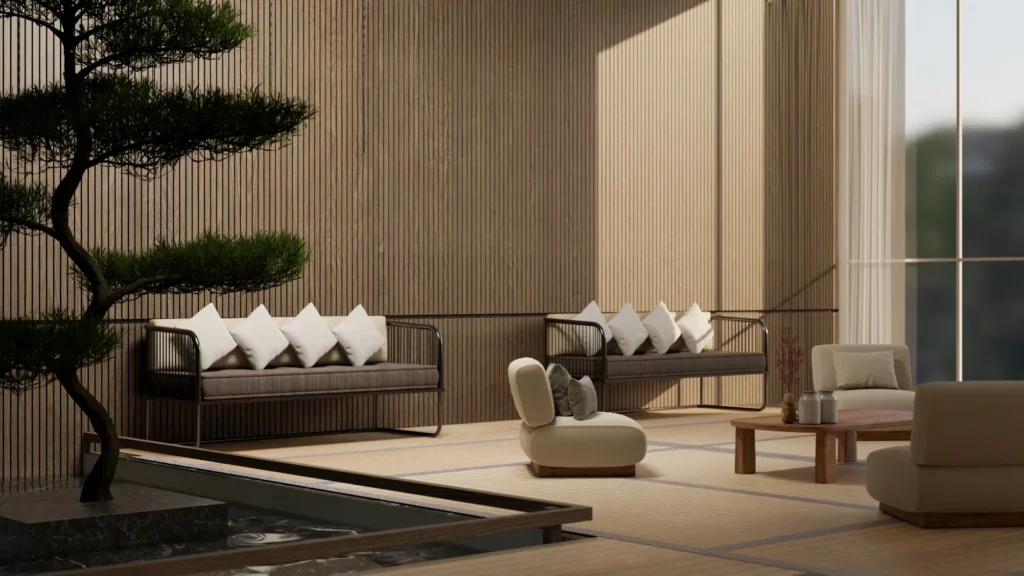
Incorporating Elements of Impermanence
Wabi-Sabi acknowledges the transient nature of life. In your interior design journey, consider elements that evolve over time. Furniture that gains character with use or a wall with peeling paint tells a story of the passage of time, adding depth to your space. You can choose fabrics that age gracefully, like linen, which softens and develops a beautiful patina over time.
Seasonal Changes and Their Influence on Design
Just as seasons change, so can your living space. Embrace the ebb and flow of seasons by incorporating elements that reflect the outdoor environment. This could be as simple as rotating seasonal decor or choosing furniture that complements the changing colors of nature. For instance, Swap out light, breezy curtains for heavier, warmer ones in the winter, creating a cozy atmosphere.
Connection To Nature
Integrating Natural Elements into Interior Design
Bring the outdoors in by incorporating natural elements like plants, stones, or water features into your interior design. These components not only establish a connection with the natural world but also enhance a feeling of serenity and equilibrium. Notice that a collection of driftwood arranged on a shelf or a vase filled with foraged branches can infuse your space with the simplicity and beauty of nature.
Creating Harmony with the Environment
Wabi-Sabi invites you to consider your surroundings and create a harmonious connection with the environment. Choose colors and materials that reflect the nature outside your window, fostering a sense of unity between your indoor and outdoor spaces. Example: If you live in a coastal area, incorporate shades of blues and natural textures like rattan to evoke the tranquility of the ocean.
In the realm of Wabi-Sabi, simplicity becomes a form of art, imperfection becomes a source of beauty, and your home becomes a reflection of the serenity found in nature.
Application Of Wabi-Sabi In Interior Design
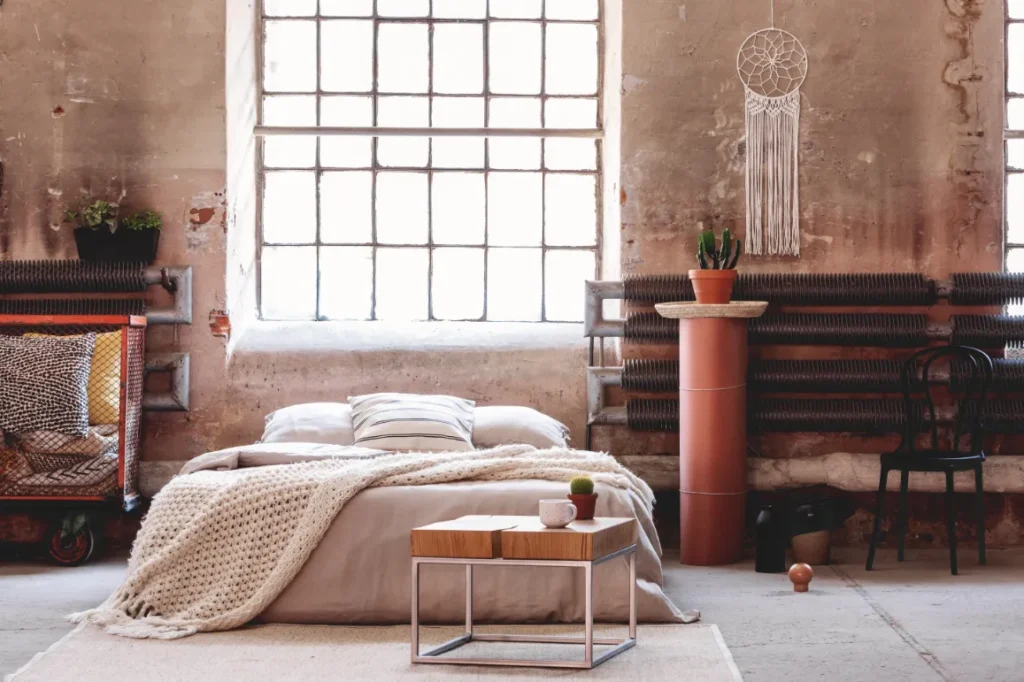
Having laid the groundwork with Wabi-Sabi’s core principles, let’s transition to the practical side, implementing this philosophy to shape your living space into a tranquil haven of authenticity.
Color Palette
Earthy Tones And Muted Colors
When it comes to color in Wabi-Sabi interior design, think of the soothing palette of nature. Earthy tones like warm browns, soft greens, and muted blues create a calming atmosphere. These colors not only mimic the natural world but also provide a neutral backdrop that allows other elements in the space to shine. Example: Instead of a vibrant red sofa, opt for a muted terracotta or sage green, creating a more subdued and tranquil ambiance.
Faded and Weathered Aesthetics
Embrace the beauty of impermanence by incorporating faded and weathered aesthetics. Furniture and decor that show signs of age add character to your space. Consider textiles with a slightly worn look or accessories with a patina that tells a story. Here you can choose faded, vintage rugs that showcase a history of use, imparting a sense of warmth and nostalgia to your room.
Furniture And Decor
Vintage and Antique Pieces
Wabi-Sabi encourages you to veer away from mass-produced items in favor of pieces with history and character. Vintage and antique furniture carry the essence of bygone eras, bringing a unique charm to your interior design. Example: Instead of a brand-new coffee table, opt for a well-worn antique piece with visible signs of age, such as dents or scratches, adding a touch of authenticity to your space.
Handcrafted and Artisanal Items
Integrate handcrafted and artisanal items into your interior design to emphasize the human touch. These pieces often showcase the craftsmanship and imperfect beauty that align with Wabi-Sabi principles. From hand-thrown ceramics to handwoven textiles, these items contribute to the overall warmth of your space. For instance, you can go for handcrafted pottery for your tableware, each piece showcasing the individuality of the artist’s touch.
Natural Materials
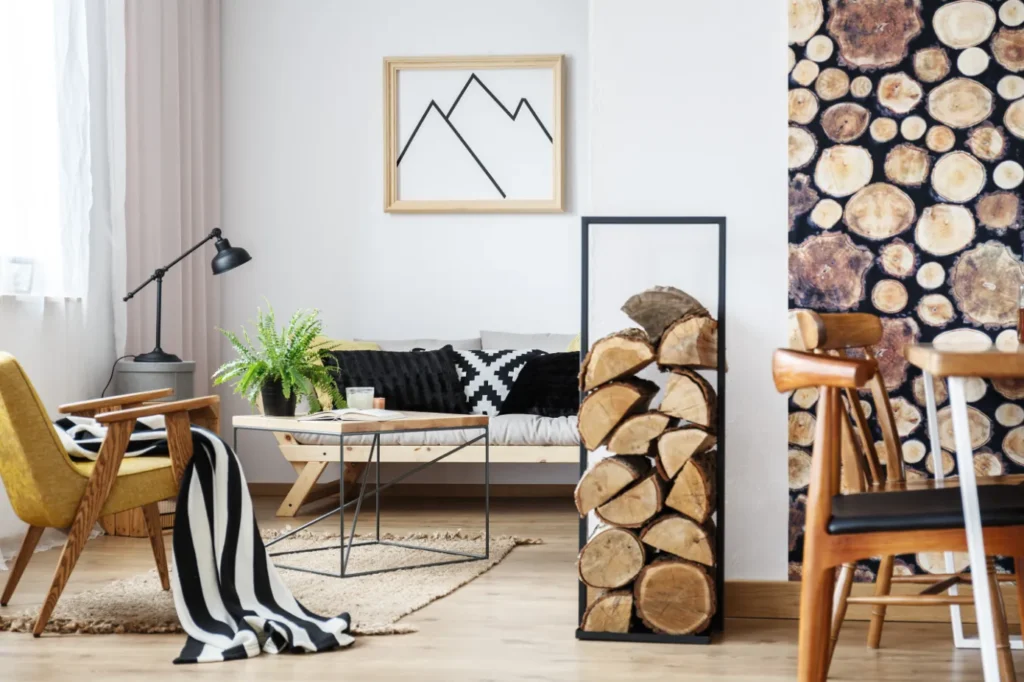
Use of Natural Materials (Wood, Stone, Clay)
Wabi-Sabi emphasizes the use of natural materials that age gracefully over time. Incorporate wood, stone, and clay into your interior design to bring a sense of warmth and authenticity. These materials often develop a patina and character that tell a story of their own. Example: Instead of synthetic materials, opt for a solid wood dining table that will age beautifully, evolving with time.
Textures That Age Gracefully
Choose textures that not only feel good but also age gracefully. Wabi-Sabi celebrates the tactile experience, so consider materials like linen, wool, or raw silk for upholstery and textiles. These textures gain character as they age, contributing to the overall charm of your space. Here, you can select a linen sofa that will develop a soft, lived-in feel over time, embodying the Wabi-Sabi aesthetic.
Layout And Spatial Design
Open Spaces and Uncluttered Layouts
Wabi-Sabi calls for simplicity and unpretentiousness in spatial design. Embrace open spaces and uncluttered layouts, allowing each element to breathe and be appreciated. Avoid overcrowding your rooms with unnecessary decor, fostering a sense of calm and spaciousness. Example: Instead of filling every corner, leave some open space in your living room, allowing for a more relaxed and uncluttered atmosphere.
Flexibility for Evolving Designs
Wabi-Sabi recognizes the transient nature of life, and your interior design should reflect this philosophy. Create a flexible layout that can evolve with time. Invest in furniture that can be easily rearranged, adapting to changing needs and seasons. For example, choose modular furniture that can be rearranged to create different seating arrangements, providing flexibility in your living space.
Incorporating Wabi-Sabi into your interior design isn’t about achieving a picture-perfect aesthetic; it’s about creating a space that evolves with time, embracing imperfection, and finding beauty in authenticity. As you navigate these elements, remember that your home reflects your journey, where every piece tells a story, and the ordinary becomes extraordinary.
Wabi-Sabi DIY: Bringing The Aesthetic Home

Embracing the Wabi-Sabi philosophy doesn’t require a complete overhaul of your living space. In fact, you can infuse the essence of Wabi-Sabi into your home through simple, do-it-yourself (DIY) techniques that celebrate imperfection and foster a tranquil atmosphere.
Simple Decorating Tips
Selecting Imperfect Items
Intentionally Begin by intentionally choosing items with imperfections. Seek out furniture, decor, or textiles that showcase signs of wear, embracing the Wabi-Sabi principle of finding beauty in the flawed. Consider a coffee mug with a slightly uneven rim or a rug with irregular patterns – each imperfection adds character. You can opt for a handcrafted ceramic vase with intentional irregularities, turning what might be perceived as flaws into unique features.
Personalizing Spaces with Handmade Elements
Wabi-Sabi encourages personalization. Infuse your space with handmade elements that carry a personal touch. This could be as simple as creating your own artwork or incorporating handcrafted items from local artisans. The goal is to surround yourself with items that have a story. Here, you may craft a simple macramé wall hanging or display a collection of handmade pottery on open shelves, bringing a sense of authenticity to your space.
Creating A Tranquil Atmosphere
Incorporating Elements of Mindfulness
Wabi-Sabi places great importance on mindfulness. Create moments of mindfulness in your space by incorporating elements that invite introspection. This could be a small meditation corner with floor cushions, a cozy reading nook with soft lighting, or a dedicated space for daily reflection. Example: Arrange a corner with a comfortable chair, a soft throw, and a small table with a scented candle, creating a serene spot for mindfulness and relaxation.
Importance of Lighting and Its Impact on Mood
Lighting plays a crucial role in setting the mood of a space. Embrace soft, natural lighting and consider the impact of different light sources on your mood. choose warm-toned bulbs and experiment with various fixtures to create a calming ambiance. For instance, you can replace harsh overhead lights with soft, pendant lights or floor lamps to achieve a more relaxed and inviting atmosphere.
Revitalizing Existing Spaces
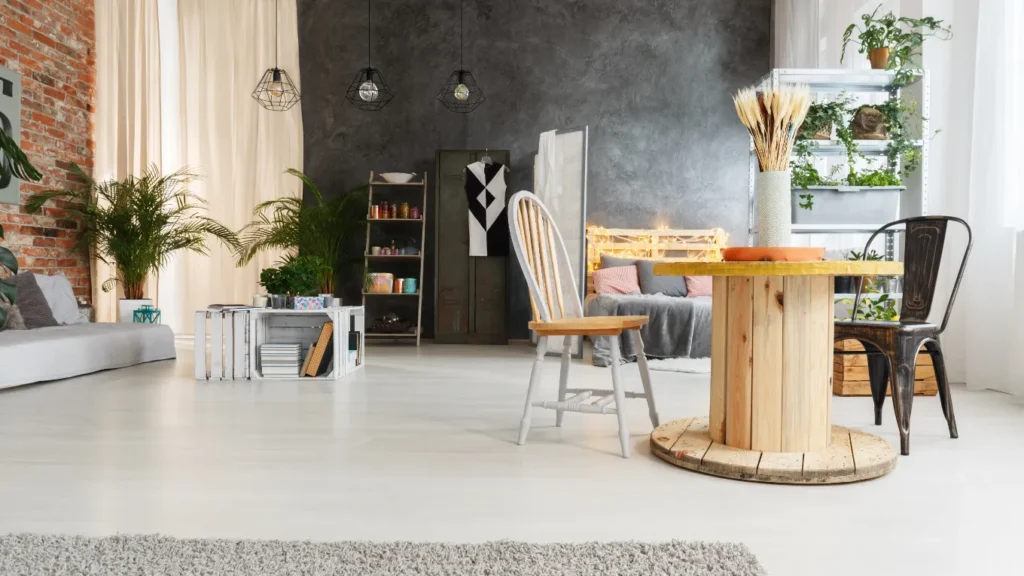
Upcycling and Repurposing Furniture
Wabi-Sabi encourages sustainable practices, making upcycling and repurposing key elements in DIY projects. Instead of discarding old furniture, consider giving it new life. Sand down wooden surfaces to reveal natural textures, or paint a piece in muted tones for a refreshed look. Turn an old wooden ladder into a stylish bookshelf or repurpose wooden crates into storage units, breathing new life into discarded items.
Rather than seeing wear and tear as a sign of aging, Wabi-Sabi celebrates these imperfections. Embrace the beauty of a well-worn chair or a scratched wooden tabletop. Such elements tell a story and contribute to the authentic character of your space. Example: Leave scratches on a wooden surface untouched or intentionally distress a piece of furniture for a vintage, worn-in look.
The Future Of Wabi-Sabi In Interior Design Journey
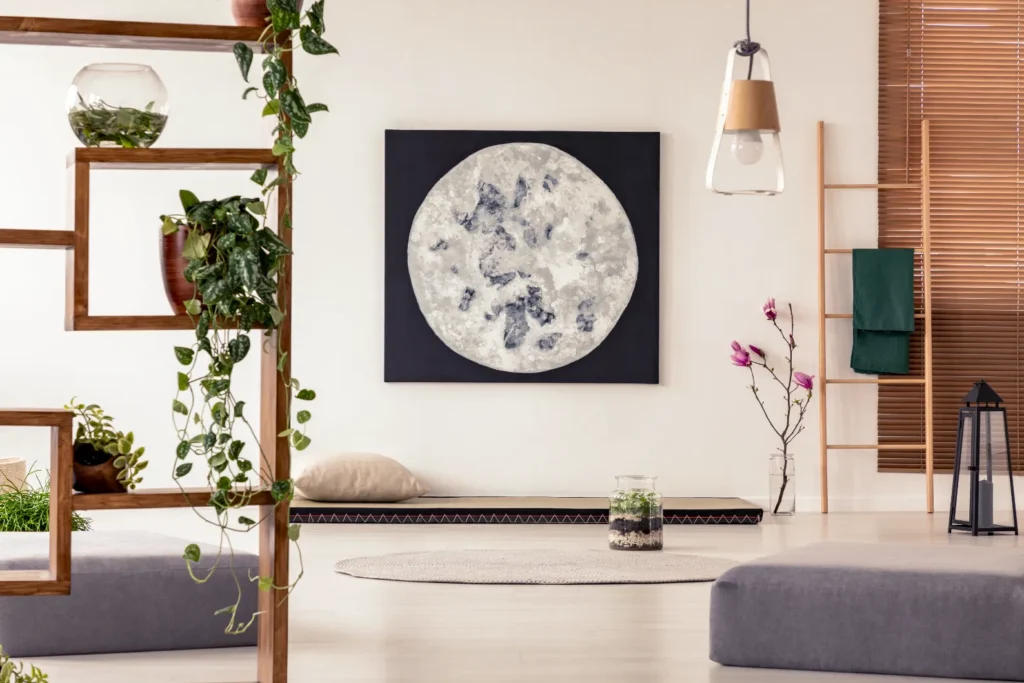
As you embrace the timeless allure of Wabi-Sabi in your interior design, it’s intriguing to consider the trajectory this philosophy is taking and its potential impact on the future of home aesthetics. Wabi-Sabi is not just a fleeting trend; it’s a mindset that resonates with the growing desire for authenticity and sustainability in design. As you look ahead in your interior design journey, consider the lasting influence Wabi-Sabi will likely exert.
The philosophy’s focus on imperfection aligns seamlessly with the evolving preferences of homeowners like yourself. In a world inundated with mass-produced perfection, Wabi-Sabi provides a refreshing departure—a return to the beauty found in the authentic and imperfect. This shift towards a more genuine and individualistic approach to design is likely to persist. Moreover, the emphasis on natural materials and sustainable practices resonates with the increasing awareness of environmental impact. Your choices in interior design can contribute to a more sustainable future, aligning with the eco-conscious direction many are leaning towards.
In a constantly progressing technological landscape, the value of the human touch becomes more pronounced. The craftsmanship and artisanal elements championed by Wabi-Sabi speak to the desire for a personal, human connection in your living spaces. The future of interior design, as you shape it, may see a harmonious blend of technological innovation and handcrafted authenticity.
Conclusion
In summary, the future of Wabi-Sabi in your interior design journey appears promising. Its enduring principles of imperfection, sustainability, and the celebration of the human touch are poised to shape homes that not only reflect your unique story but also contribute to a more mindful and sustainable world. As you continue to infuse Wabi-Sabi into your spaces, you’re not just following a trend; you’re pioneering a timeless and meaningful approach to interior design.
As we wrap up our journey through the wonders of Wabi-Sabi in interior design, keep in mind that designing a home is more than just about looks—it’s about crafting a space that tells your unique story. Embracing imperfections, simplicity, and a connection to nature goes beyond trends; it’s about building a timeless and genuine sanctuary.
As you navigate your interior design adventure, remember Wabi-Sabi isn’t about chasing perfection but discovering beauty in imperfections, turning each element in your home into a reflection of life’s distinctive journey. Whether intentionally choosing imperfect items, adding mindful touches for a tranquil atmosphere, or reviving spaces through DIY projects, every decision contributes to the authentic allure of Wabi-Sabi.
At The White Frame, we turn extravagant dreams into functional, well-crafted realities. We handcraft luxurious homes, tailored to the preferences of our diverse clientele in Gurgaon, Noida, and Delhi-NCR. We’re redefining the notion of modern opulence, proving that luxury doesn’t have to strain the budget. We’re driven by a core belief that our in-house technology (Twinn) streamlines processes, making the journey to your dream home effortless and trouble-free. Our team of interior designers is well-versed in optimizing space and crafting functional, aesthetically pleasing interiors that exude class, sophistication, and beauty.
Explore some of our work here and Get in Touch with us Today!


